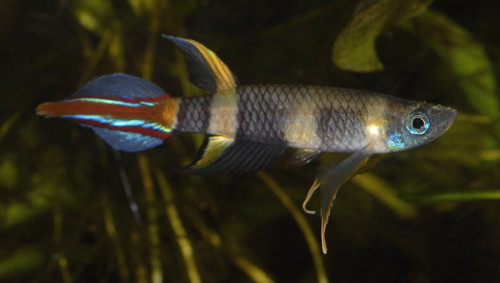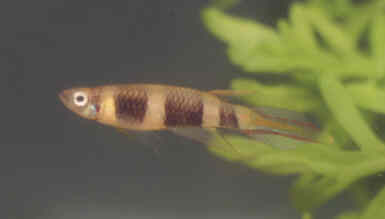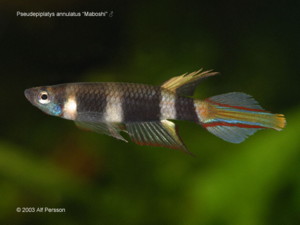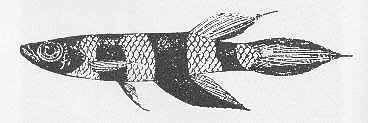Pseudepiplatys annulatus (Boulenger 1915)

CI 06. USA Import. Note extensions
in ventral fins.
Photo courtesy of Tony Terceira.
| Meaning of Name |
annulatus, meaning rings. Also, generally referred to as the 'clown killie'. | |||||||||||
| First Description |
Boulenger G.A 1915. Descriptions of new freshwater fishes from Sierra Leone. Annals & Magazine of Natural History (8) 15 (86): p 203. | |||||||||||
| Size |
3·5 cm | |||||||||||
| Meristics |
| |||||||||||
| Karyotype |
n = 25, A = 43 (Scheel 1968) | |||||||||||
| Sub-Genus |
| |||||||||||
| Group |
Unrelated, a group of it's own. | |||||||||||
| Synonyms |
| |||||||||||
|
Populations
|
Commercial Shipments - A lot of introductions are made from commercial shipments, generally bought in retailers or found in importers boxes.
Monrovia - Collected by Stenholt Clausen. BKA Species Import Committee brought in wild fish from this location in May 1981.
Maboshi - Maintained in the DKG 2002 & possibly earlier. Collection SLCD 84/32 collected by Christian Cauvet & Jérôme Detienne, KCF in November 1984.
Petifu Junction SLCD 84 / 4 - Collected by Christian Cauvet & Jérôme Detienne, KCF in November 1984. Serabatu SLCD 84 / 28 - Serabu may be a corruption. Collected by Christian Cauvet & Jérôme Detienne, KCF in November 1984.
| |||||||||||
| Type Locality |
Matca, Sierra Leone. Boulenger spells this Maka. Many localities are shown on maps with this location. The closest is at the mouth of the Moa River.
| |||||||||||
| Distribution |
Inhabits coastal lowland areas from Guinea through Sierra Leone & into Liberia. http://homepage.uibk.ac.at/homepage/c102/c102mr/epiplaty/annulatu.htm | |||||||||||
| Habitat |
A varied habitat. Found in rainforest & savannah in pools, smaller streams & quieter areas of small rivers. They are found under bordering vegetation & lily pads. As they inhabit coastal areas they have also been found in slightly brackish water. Scheel in ROTOW 1 describes their water conditions in the wild as 'rather hot, shallow, usually stagnant & probably soft & acid'. Sympatric species include Epiplatys fasciolatus; E.barmoiensis; Callopanchax occidentalis & Scriptaphyosemion liberiense. | |||||||||||
| Distinguishing Characteristics | Unmistakable, with vertical bands of chocolate & cream along the body & the unique colouration/pattern of the caudal fin. | |||||||||||
| Colour/Pattern Variability | Medium. The caudal fin can be variable between populations. Unpaired fins can also be found with differing colours. | |||||||||||
| History |
Boulenger described this species from material collected at Maka (sometimes referenced as Matca) by Thomas in 1913. Known to have been in the hobby in 1955 & 1960. Kretschmar, Sigrid & G.Benl sent 27 fish
in 2 shipments from Guinee to Roloff in 1965. It is thought all previous
imports had been lost in the hobby until this import. Introduced to the BKA by Leif Christensen in
the latter half of 1966. Another import followed later, being collected
by Roloff in Sierra Leone. Another import was received by the BKA on
7th February 1973. | |||||||||||
| Breeding Notes |
Scheel
in ROTOW 1 found the eggs to be sensitive to bacterial infection on the egg membrane
causing premature hatching. He used water with a minimum of calcium & magnesium
& an acid pH of 5·0. Acriflavine & methylene blue in equal parts
(2 ppm) were also used. Incubation period at 74°F has been reported at 12 days. BKA newsletter No.86, October 1972. Planted tanks
are preferred with subdued lighting. Water temperature was higher than
that for other killies & 74°F was satisfactory. George Mamanov in BKA newsletter No. 402, March 1999 reported eggs take 8-12 days incubation in water at 22-25°C. Adding clean, fresh water stimulates hatching. Growth rate is slow but speeds up when the first vertical bands start to appear. Fry can die easily if the water gets polluted so regular water changes are needed. | |||||||||||
| Diameter of Egg | Very small. 0·9 - 0·95 mm. | |||||||||||
| Remarks |
Scheel found that by crossing populations from Kasewe & Monrovia a stronger fish resulted which were easier to breed & maintain than pure populations. This species prefers to take food from the surface. Wingless fruit fly or mosquito larvae are good foods. |







